Geochronological and Geochemical Study of Zircon from Tourmaline-Muscovite Granites of the Archaean Kolmozero–Voronya Greenstone Belt: Insights into Sources of the Rare-Metal Pegmatites
Abstract
1. Introduction
2. Geological Setting of the Kolmozero–Voronya Greenstone Belt
3. Geological Setting and Mineral Composition of the Tourmaline-Muscovite Granites (TMG)
4. Analytical Methods
5. Results
5.1. Major and Trace Element Composition of Tourmaline-Muscovite Granites (TMG)
5.2. SIMS (REE) Study of Zircons
5.3. U-Pb (SHRIMP RG) Dating of Zircons
6. Discussion
7. Conclusions
Author Contributions
Funding
Conflicts of Interest
References
- Zagorsky, V.E.; Makagon, V.M.; Shmakin, B.M. Granitic Pegmatites. Rare-Metal Pegmatites; Siberian Branch of the Russian Academy of Sciences: Novosibirsk, Russia, 1997; Volume 2, pp. 1–278. (In Russian) [Google Scholar]
- Tkachev, A.V. Evolution of metallogeny of granitic pegmatites associated with orogens throughout geological time. Geol. Soc. London, Spéc. Publ. 2011, 350, 7–23. [Google Scholar] [CrossRef]
- Mccauley, A.; Bradley, D.C. The global age distribution of granitic pegmatites. Can. Miner. 2014, 52, 183–190. [Google Scholar] [CrossRef]
- Černý, P. Petrogenesis of granitic pegmatites. In Granitic Pegmatites in Science and Industry; Mineral. Assoc. Can. Short Course; Mineralogical Association of Canada: Québec, QC, Canada, 1982; Volume 8, pp. 405–461. [Google Scholar]
- Černý, P. Rare-element granite pegmatites. Part I: Anatomy and internal evolution of pegmatite deposits. Geosci. Can. 1991, 18, 49–67. [Google Scholar]
- Černý, P. Rare-element granite pegmatites. Part II: Regional to global environments and petrogenesis. Geosci. Can. 1991, 18, 68–81. [Google Scholar]
- Černý, P.; London, D.; Novak, M. Granitic pegmatites as reflections of their sources. Elements 2012, 8, 257–261. [Google Scholar] [CrossRef]
- London, D. Pegmatites. Can. Mineral. 2008, 10, 347. [Google Scholar]
- London, D. Ore-forming processes within granitic pegmatites. Ore Geol. Rev. 2018, 101, 349–383. [Google Scholar] [CrossRef]
- Černý, P.; Ercit, T.S. Classification of granitic pegmatites. Can. Miner. 2005, 43, 2005–2026. [Google Scholar] [CrossRef]
- Gordienko, V.V. Mineralogy, Geochemistry and Genesis of Spodumene Pegmatites; Nedra: Leningrad, Russia, 1970; 240p. (In Russian) [Google Scholar]
- Gordienko, V.V.; Krivovichev, V.G.; Syritso, L.F. Metasomitites of Pegmatite Fields; LGU: Leningrad, Russia, 1987; 221p. (In Russian) [Google Scholar]
- Gordienko, V.V. Granite Pegmatites; Saint Petersburg University: St. Petersburg, Russia, 1996; 272p. (In Russian) [Google Scholar]
- Voloshin, A.V.; Pakhomovsky, Y.A. Ta and Nb Mineralogy in Rare-Metal Pegmatites; Nauka: Leningrad, Russia, 1988; 240p. (In Russian) [Google Scholar]
- Morozova, L.N. Lithium Kolmozero deposit of rare metal pegmatites: New data on rare element composition (Kola peninsula). Lithosphere 2018, 18, 82–98. [Google Scholar] [CrossRef]
- Badanina, E.V.; Sitnikova, M.A.; Gordienko, V.V.; Melcher, F.; Gabler, H.-E.; Lodziak, J.; Syritso, L.F. Mineral chemistry of columbite-tantalite from spodumene pegmatites of Kolmozero, Kola Peninsula (Russia). Ore Geol. Rev. 2015, 64, 720–735. [Google Scholar] [CrossRef]
- Ginzburg, A.I.; Timofeev, I.N.; Pheldman, L.G. Fundamentals of the Geology of Granite Pegmatites; Nauka: Moscow, Russia, 1979; 296p. (In Russian) [Google Scholar]
- Maslennikov, V.A. Stratigraphy of the Polmos and Poros Formations; LAGED: Leningrad, Russia, 1963; Volume 15, pp. 69–72. (In Russian) [Google Scholar]
- Sosedko, A.F. Materials on Geology and Geochemistry of Granite Pegmatites; Gosgeoltekhizdat: Moscow, Russia, 1961; 152p. (In Russian) [Google Scholar]
- Batieva, I.D.; Bel’kov, I.V.; Vetrin, V.R.; Vinogradov, A.N.; Efimov, M.M.; Belolipetskii, A.P.; Bolotov, V.I.; Vinogradova, G.V.; Dokuchaeva, V.S.; Dubrovskii, M.I.; et al. Precambrian Igneous Formations of the Northeastern Part of the Baltic Shield; Nauka: Leningrad, Russia, 1985; 176p. (In Russian) [Google Scholar]
- Kudryashov, N.M.; Petrovsky, M.N.; Mokrushin, A.V.; Elizarov, D.V. Neoarchean sanukitoid magmatism in the Kola Region: Geological, petrochemical, geochronological, and isotopic–geochemical data. Petrology 2013, 21, 351–374. [Google Scholar] [CrossRef]
- Kozlov, N.E.; Sorochtin, N.O.; Glaznev, V.N.; Kozlova, N.E.; Ivanov, A.A.; Kudryashov, N.M.; Martinov, E.V.; Tyuremnov, V.A.; Matyushkin, A.V.; Osipenko, L.G. Geology of the Archean Baltic Shield; Nauka: St. Petersburg, Russia, 2006; 345p. (In Russian) [Google Scholar]
- Zozulya, D.R.; Bayanova, T.B.; Eby, G.N. Ceology and age of the Late Archean Keivy alkaline Province, Northeastern Baltic Shield. J. Geol. 2005, 113, 601–608. [Google Scholar] [CrossRef]
- Pushkarev, Y.D.; Kravchenko, E.V.; Shestakov, G.I. Geochronological Benchmarks of the Precambrian of the Kola Peninsula; Nauka: Leningrad, Russia, 1978; p. 136. (In Russian) [Google Scholar]
- Belolipetskii, A.P.; Gaskel’berg, V.G.; Gaskel’berg, L.A.; Antonyuk, E.S.; Il’in, Y.I. Geology and Geochemistry of the Early Precambrian Metamorphic Complexes of the Kola Peninsula; Nauka: Leningrad, Russia, 1980; 240p. (In Russian) [Google Scholar]
- Pozhilenko, V.I.; Gavrilenko, B.V.; Zhirov, D.V.; Zhabin, S.V. Geology of Mineral Areas of the Murmansk Region; KSC RAS: Apatity, Russia, 2002; 360p. (In Russian) [Google Scholar]
- Kudryashov, N.M.; Lyalina, L.M.; Apanasevich, E.A. Age of Rare-Metal Pegmatites from the Vasin-Myl’k Deposit (Kola Region): Evidence from U–Pb Geochronology of Microlite. Dokl. Earth Sci. 2015, 461, 321–3250. [Google Scholar] [CrossRef]
- Kudryashov, N.M.; Skublov, S.G.; Galankina, O.L.; Udoratina, O.V.; Voloshin, A.V. Abnormally high-hafnium zircon from rare-metal pegmatites of the Vasin-Mylk deposit (the northeastern part of the Kola Peninsula) // Chemie der Erde. Geochemistry 2019, 6, 125489. [Google Scholar] [CrossRef]
- Kudryashov, N.M.; Mokrushin, A.V. Mesoarchean Gabbroanorthosite Magmatism of the Kola Region: Petrochemical, Geochronological, and Isotope-Geochemical Data. Petrology 2011, 19, 169–184. [Google Scholar] [CrossRef]
- Vrevskii, A.B. Age and sources of the anorthosites of the neoarchean Kolmozero-Voron’ya greenstone belt (Fennoscandian shield). Petrology 2016, 24, 527–542. [Google Scholar] [CrossRef]
- Ostroumov, G.V. Unified Methods for the Analysis of Silicate Rocks Using Complexonometry; All-Union Research Institute of Mineral Raw Materials: Moscow, Russia, 1979; 33p. (In Russian) [Google Scholar]
- Ronkin, Y.L.; Lepikhina, O.P.; Golik, S.V.; Zhuravlev, D.Z.; Popova, O.Y. Multielement Analysis of Geological Samples by Acid Decomposition and Termination on HR ICPMS Element 2. Information Digest of Scientific Works of the IGG UB RAS; IGG UB RAS: Ekaterinburg, Russia, 2005; pp. 423–433. (In Russian) [Google Scholar]
- Ireland, T.R. Ion Microprobe Mass-Spectrometry: Techniques and Applications in Cosmochemistry and Geochronology. In Advances in Analytical Geochemistry; Hyman, M., Rowe, M., Eds.; JAI Press: London, UK, 1993; Volume 2, pp. 1–118. [Google Scholar] [CrossRef]
- Coble, M.A.; Vazquez, J.; Barth, A.P.; Wooden, J.; Burns, D.; Kylander-Clark, A.; Jackson, S.; Vennari, C.E. Trace Element Characterization of MAD-559 Zircon Reference Material for Ion Microprobe Analysis. Geostand. Geoanalytical Res. 2018, 42, 481–497. [Google Scholar] [CrossRef]
- Ludwig, K.R. SQUID 2: A User’s Manual; Berkeley Geochronology Centre Special Publication: Berkeley, CA, USA, 2009; Volume 5, pp. 1–110. [Google Scholar]
- Boynton, W.V. Cosmochemistry of the rare earth elements: Meteorite studies. In Rare Earth Element Geochemistry; Henderson, P., Ed.; Elsevier: Amsterdam, The Netherlands, 1984; pp. 63–114. [Google Scholar]
- Watson, E.B.; Wark, D.A.; Thomas, J.B. Crystallization thermometers for zircon and rutile. Contrib. Miner. Pet. 2006, 151, 413–433. [Google Scholar] [CrossRef]
- Ludwig, K.R. Isoplot 3.75, a Geochronological Toolkit for Excel; Berkeley Geochronology Center Special Publication: Berkeley, CA, USA, 2012; Volume 5, pp. 1–75. [Google Scholar]
- Middlemost, E.A.K. Naming materials in the magma/igneous rock system. Earth-Sci. Rev. 1994, 37, 215. [Google Scholar] [CrossRef]
- Wedepohl, K.H. The composition of the continental crust. Geochim. Cosmochim. Acta 1995, 59, 1217–1232. [Google Scholar] [CrossRef]
- Hoskin, P.W.O. Trace-element composition of hydrothermal zircon and the alteration of Hadean zircon from the Jack Hills, Australia. Geochim. Cosmochim. Acta 2005, 69, 637–648. [Google Scholar] [CrossRef]
- Sweetapple, M.T.; Collins, P.L.F. Genetic framework for the classification and distribution of Archean rare metal pegmatites in the North Pilbara Craton, Western Australia. Econ. Geol. 2002, 97, 873–895. [Google Scholar] [CrossRef]
- Zagorsky, V.E.; Vladimirov, A.G.; Makagon, V.M.; Kuznetsova, L.G.; Smirnov, S.Z.; D’yachkov, B.A.; Annikova, I.Y.; Shokal’sky, S.P.; Uvarov, A.N. Large fields of spodumene pegmatites in the settings of rifting and postcollisional shear–pull-apart dislocations of continental lithosphere. Russ. Geol. Geophys. 2014, 55, 237–251. [Google Scholar] [CrossRef]
- Annikova, I.Y.; Vladimirov, A.G.; Smirnov, S.Z.; Gavryushkina, O.A. Geology and Mineralogy of the Alakha Spodumene Granite Porphyry Deposit, Gorny Altai, Russia. Geol. Ore Depos. 2016, 58, 404–426. [Google Scholar] [CrossRef]
- Xiang, W.; Minghua, R.; Jie, C. The muscovite granites: Parental rocks to the Nanling Range tungsten mineralization in South China. Ore Geol. Rev. 2017, 88, 702–717. [Google Scholar] [CrossRef]
- Watson, E.B. Zircon saturation in felsic liquids: Experimental results and applications to trace element geochemistry. Contrib. Miner. Petrol. 1979, 70, 407–419. [Google Scholar] [CrossRef]
- Watson, E.B.; Harrison, T.M. Zircon saturation revisited: Temperature and com-position effects in a variety of crustal magma types. Earth Planet. Sci. Lett. 1983, 64, 295–304. [Google Scholar] [CrossRef]
- Corfu, F.; Hanchar, J.M.; Hoskin, P.W.O.; Kinny, P. Atlas of zircon textures. Rev. Miner. Geochem. 2003, 53, 469–500. [Google Scholar] [CrossRef]
- Rubatto, D. Zircon: The Metamorphic Mineral. Rev. Miner. Geochem. 2017, 83, 261–295. [Google Scholar] [CrossRef]
- Geisler, T.; Seydoux-Guillaume, A.M.; Wiedenbeck, M.; Wirth, R.; Berndt, J.; Zhang, M.; Mihailova, B.; Putnis, A.; Salje, E.K.H.; Schlüter, J. Periodic precipitation pattern formation in hydrothermally treated metamict zircon. Am. Miner. 2004, 89, 1341–1347. [Google Scholar] [CrossRef]
- Nasdala, L.; Kronz, A.; Wirth, R.; Vaczi, T.; Perez-Soba, C.; Willner, A.; Kennedy, A.K. The phenomenon of deficient electron microprobe totals in radiation-damaged and altered zircon. Geochim. Cosmochim. Acta 2009, 73, 1637–1650. [Google Scholar]
- Zamyatin, D.A.; Shchapova, Y.V.; Votyakov, S.L.; Nasdala, L.; Lenz, C. Alteration and chemical U-Th-total Pb dating of heterogeneous high-uranium zircon from a pegmatite from the Aduiskii massif, middle Urals, Russia. Miner. Pet. 2017, 111, 475–497. [Google Scholar] [CrossRef]
- Ewing, R.C.; Meldrum, A.; Wang, L.; Weber, W.J.; Corrales, L.R. Radiation effects in zircon. Rev. Miner. Geochem. 2003, 53, 387–425. [Google Scholar] [CrossRef]
- Geisler, T.; Schaltegger, U.; Tomaschek, F. Re-equilibration of zircon in acqueous fluids and melts. Elements 2007, 3, 43–50. [Google Scholar] [CrossRef]
- Belousova, E.; Griffin, W.; O’Reilly, S.Y.; Fisher, N. Igneous zircon: Trace element composition as an indicator of source rock type. Contrib. Miner. Pet. 2002, 143, 602–622. [Google Scholar] [CrossRef]
- Grimes, C.B.; Wooden, J.L.; Cheadle, M.J.; John, B.E. “Fingerprinting” tectono-magmatic provenance using trace elements in igneous zircon. Contrib. Miner. Pet. 2015, 170, 46. [Google Scholar] [CrossRef]
- Rubatto, D.; Gebauer, D. Use of cathodoluminescence for U–Pb zircon dating by ion microprobe: Some examples from the Western Alps. In Cathodoluminescence in Geosciences; Pagel, M., Barbin, V., Blanc, P., Ohnenstetter, D., Eds.; Springer: New York, NY, USA, 2000; pp. 373–400. [Google Scholar]
- Schaltegger, U.; Fanning, M.; Günther, D.; Maurin, J.C.; Schulmann, K.; Gebauer, D. Growth, annealing and recrystallization of zircon and preservation of monazite in high-grade metamorphism: Conventional and in-situ U–Pb isotope, cathodoluminescence and microchemical evidence. Contrib. Miner. Pet. 1999, 134, 186–201. [Google Scholar] [CrossRef]
- Rubatto, D. Zircon trace element geochemistry: Distribution coefficients and the link between U–Pb ages and metamorphism. Chem. Geol. 2002, 184, 123–138. [Google Scholar] [CrossRef]
- Watson, E.B.; Harrison, T.M. Zircon thermometer reveals minimum melting conditions on earliest Earth. Science 2005, 308, 841–844. [Google Scholar] [CrossRef]
- Ferry, J.M.; Watson, E.B. New thermodynamic models and revised calibrations for the Ti-in-zircon and Zr-in-rutile thermometers. Contrib. Miner. Pet. 2007, 154, 429–437. [Google Scholar] [CrossRef]
- Myskova, T.A.; Gglebovitsky, V.A.; Mil’kevich, R.I.; Berezhnaya, N.G.; Skublov, S.G. Improvement of composition and age of aluminum gneisses of the Uragubskaya greenstone Later Archaean structure, Kola Peninsula. Notes Russ. Miner. Soc. 2010, 139, 15–21. (In Russian) [Google Scholar]
- Kudryashov, N.M.; Kalinin, A.A.; Lyalina, L.M.; Serov, P.A.; Elizarov, D.V. Gold Occurrences in the Kolmozero-Voronya Archean greenstone belt, Kola region: Geological, mineralogical, geochronological, and isotope-geochemical characteristics. Lithosphere 2015, 6, 83–100. [Google Scholar]
- Balashov, Y.A.; Bayanova, T.B.; Mitrofanov, F.P. Isotope data on the age genesis of layered basic-ultrabasic intrusions in the Kola Peninsula and northern Karelia, northeastern Baltic Shield. Precambr. Res. 1993, 64, 197–205. [Google Scholar] [CrossRef]
- Amelin, Y.V.; Semenov, V.S. Nd and Sr isotopic geochemistry of mafic layered intrusions in the eastern Baltic shield: Implications for the evolution of Paleoproterozoic continental mafic magmas. Contrib. Miner. Pet. 1996, 124, 255–272. [Google Scholar] [CrossRef]

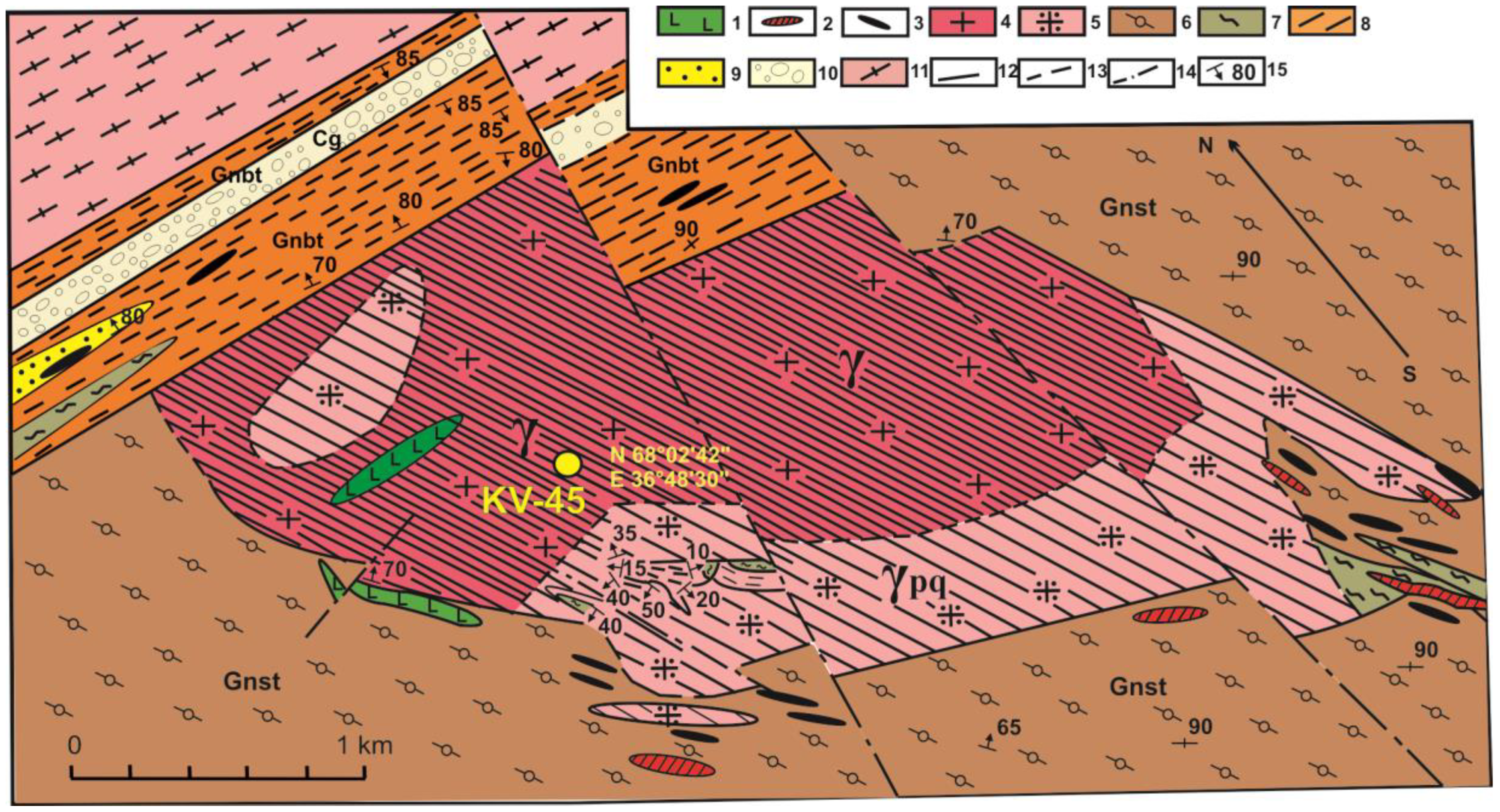

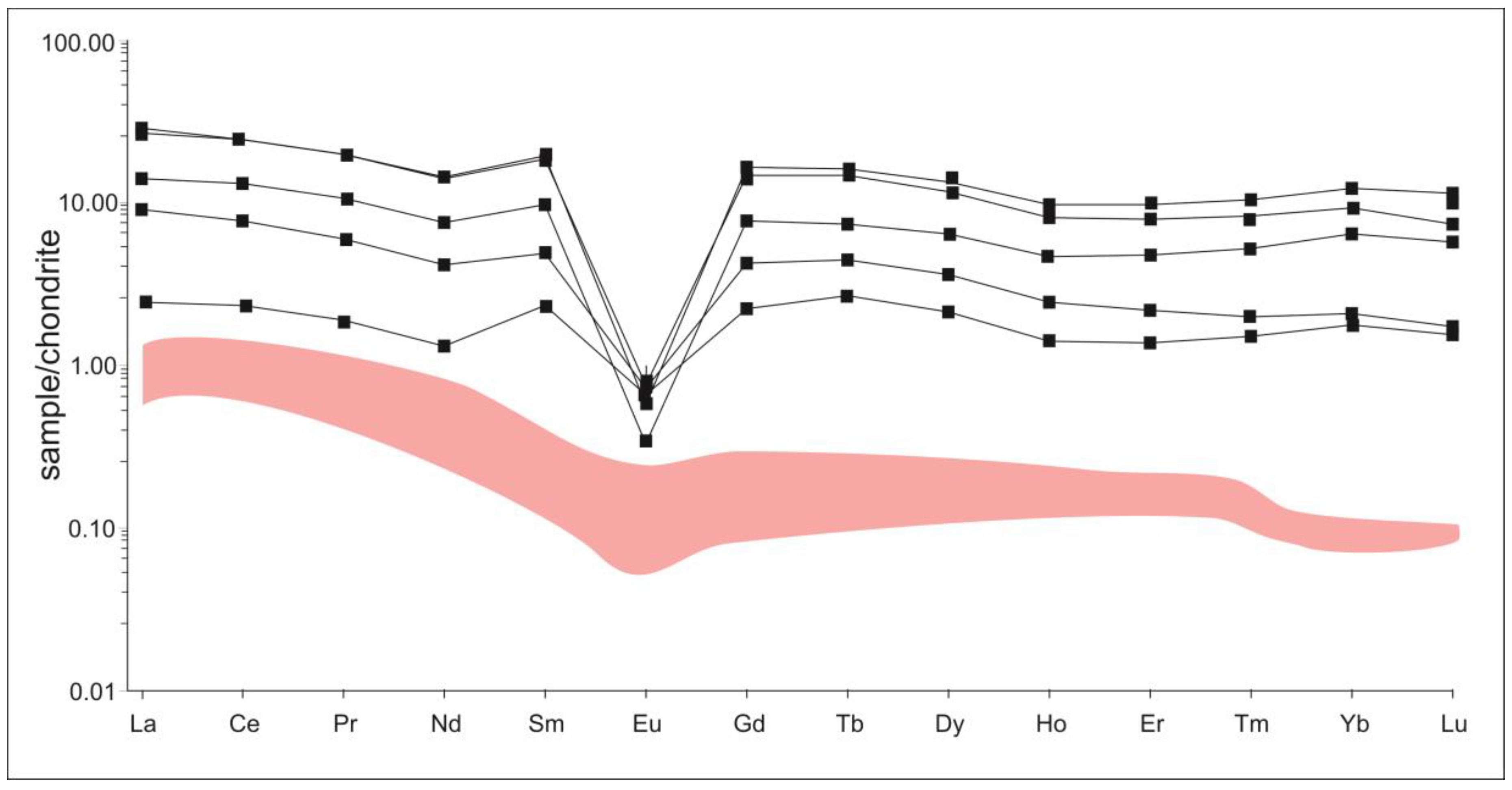
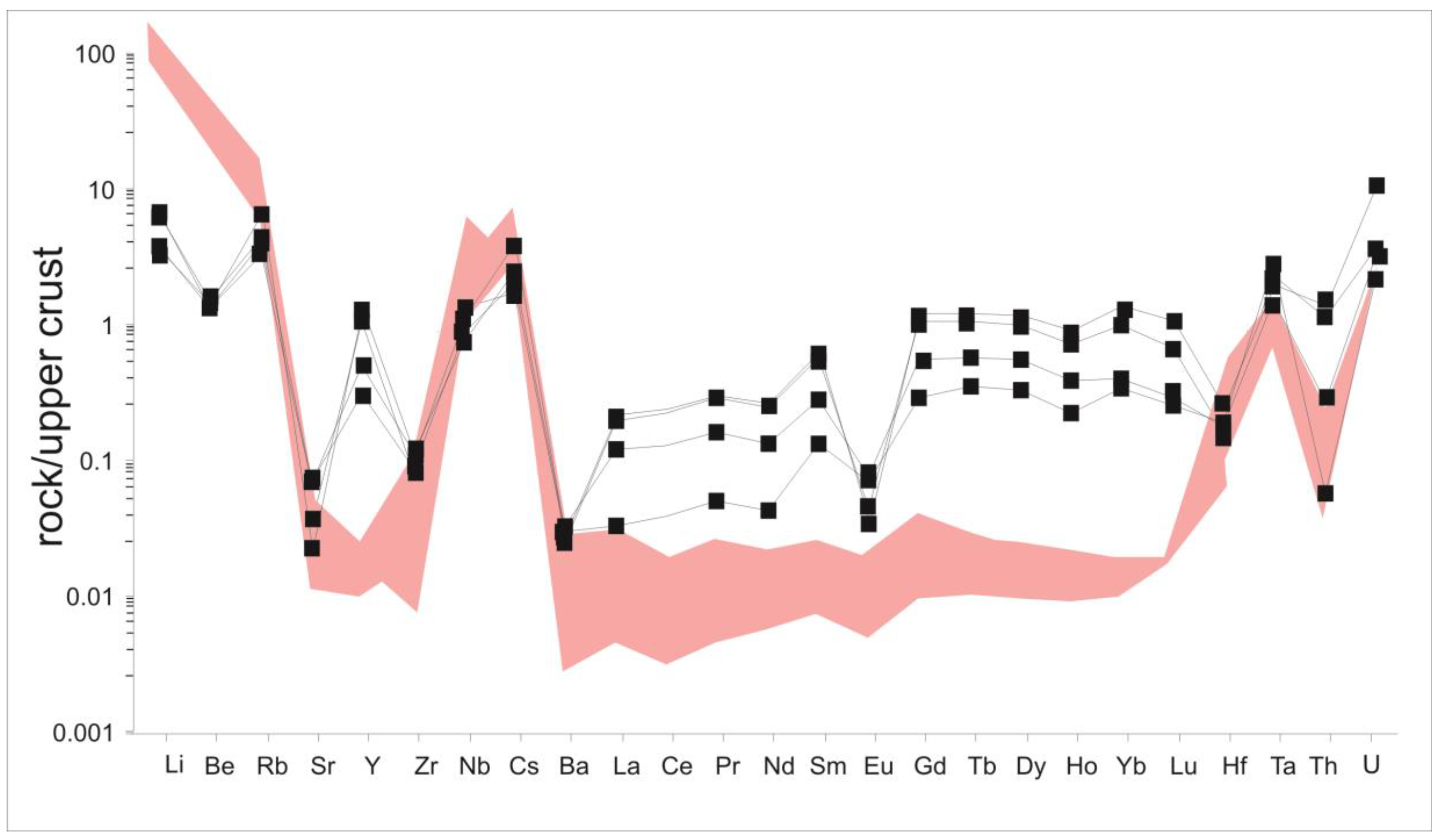
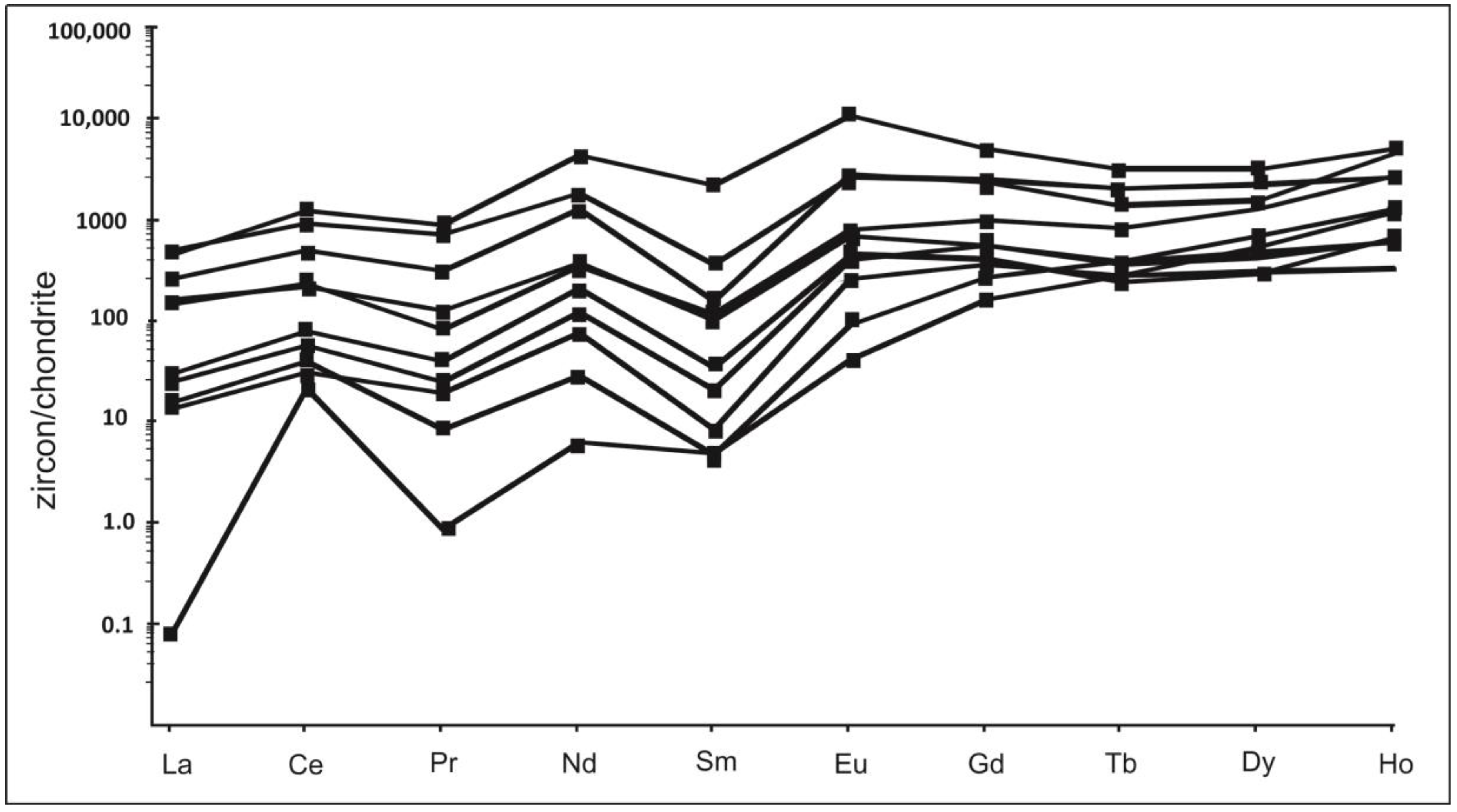
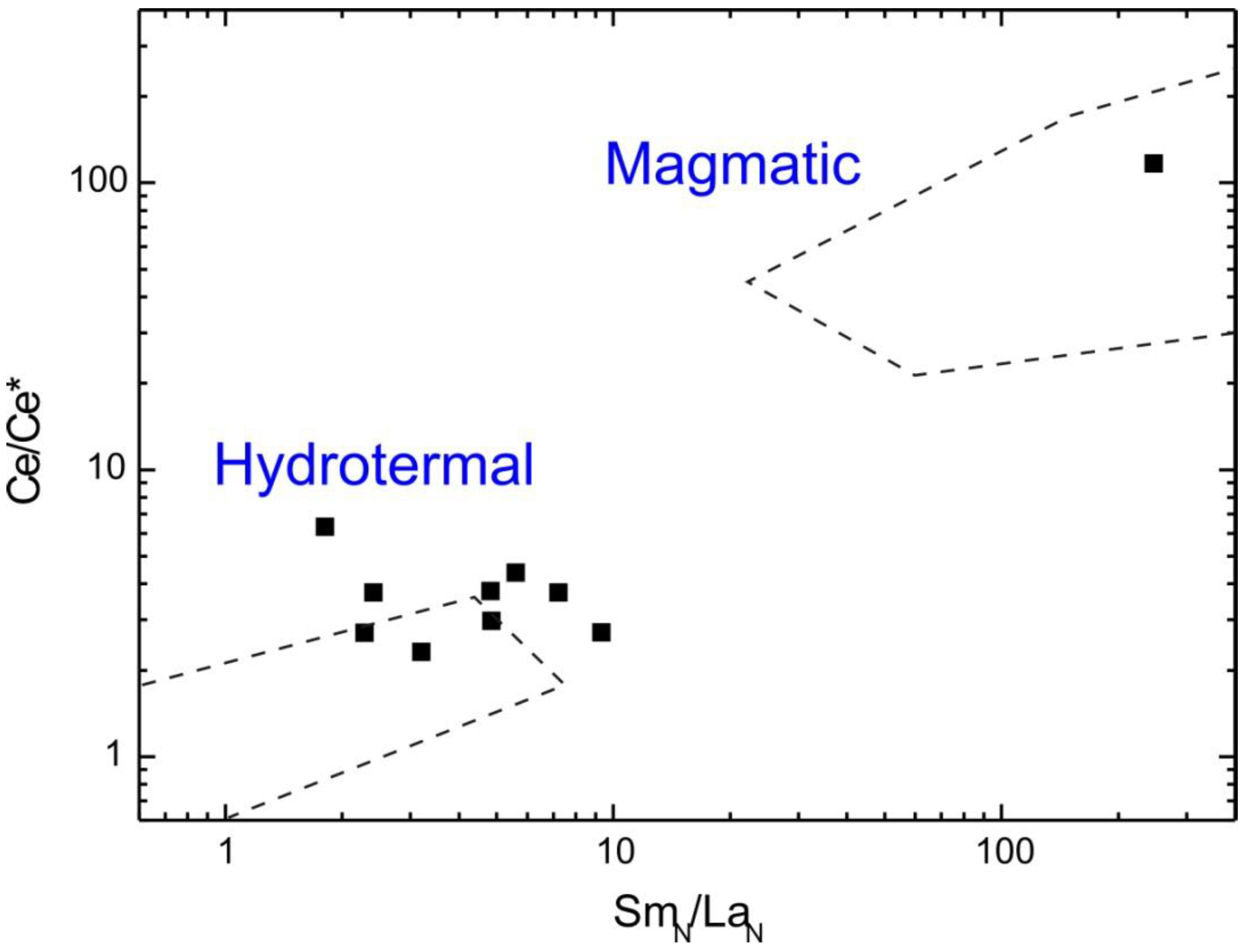
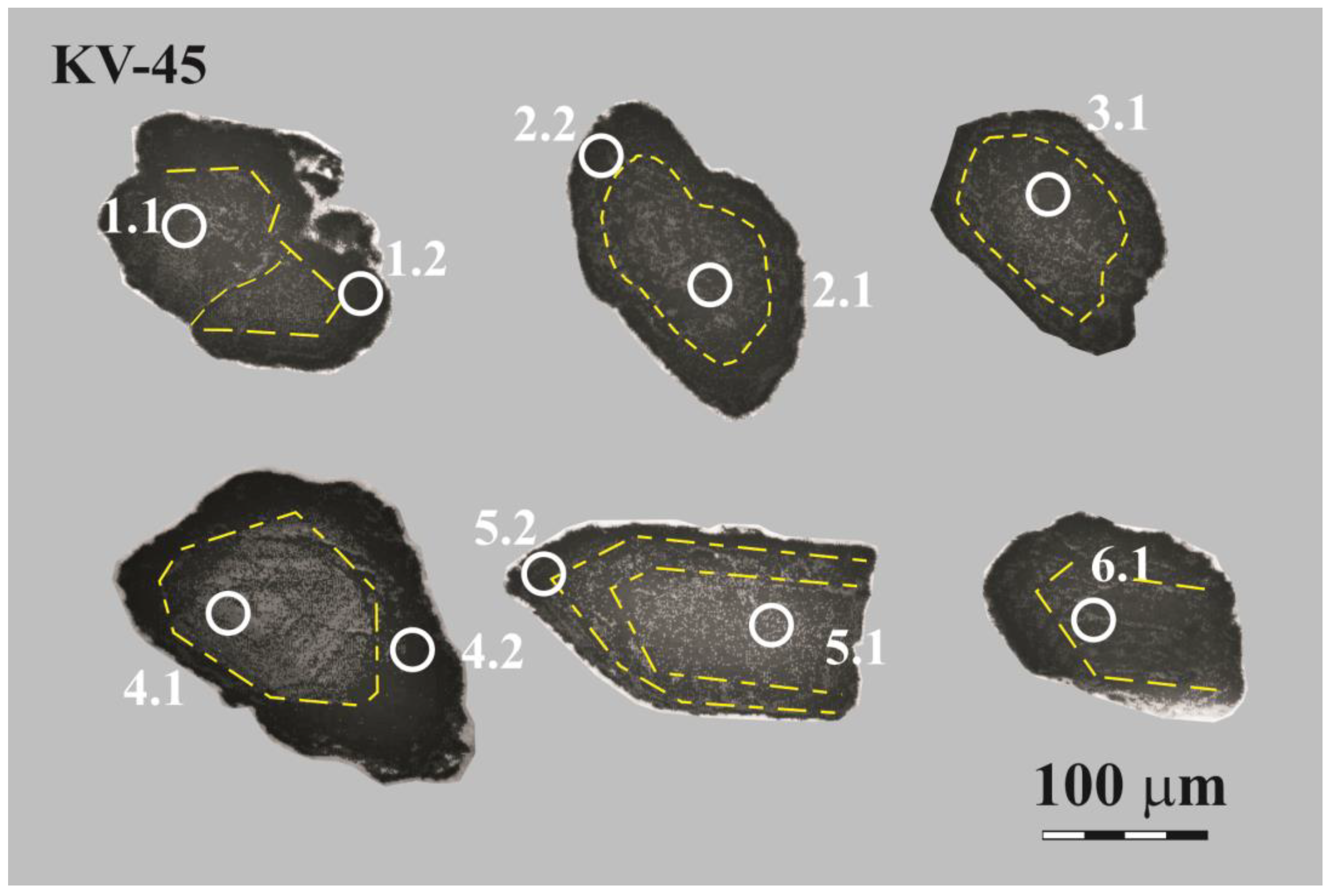
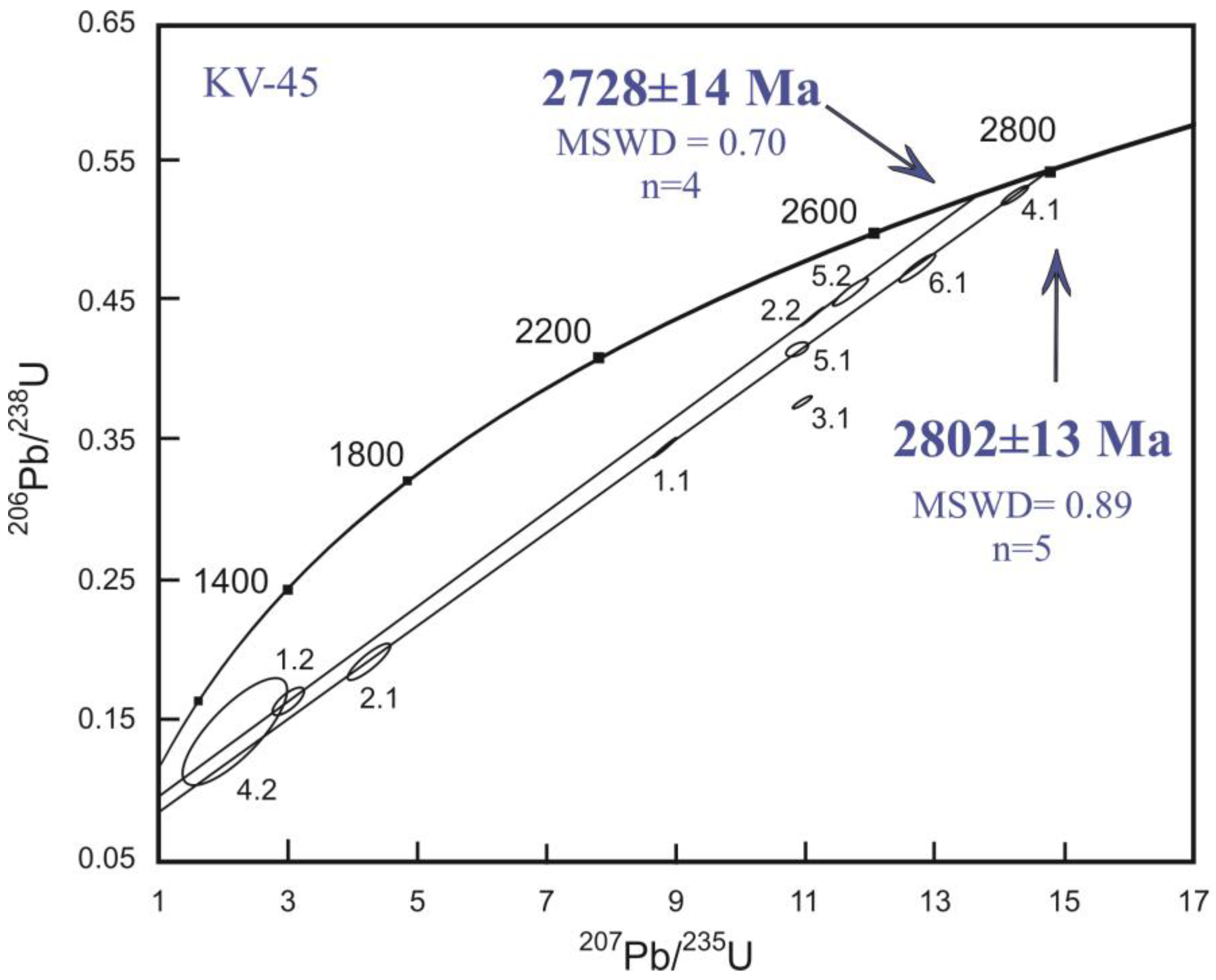
| Element | KV-45 | KV-45/1 | KV-110/1 | KV-110/2 | KV-110/3 | Tourmaline-Muscovite Granite (n = 18), [13] |
|---|---|---|---|---|---|---|
| SiO2 | 74.52 | 73.14 | 73.6 | 74.21 | 75.35 | 73.83 |
| TiO2 | 0.08 | 0.06 | 0.04 | 0.02 | 0.02 | 0.1 |
| Al2O3 | 14.48 | 14.78 | 14.92 | 13.78 | 13.9 | 14.22 |
| Fe2O3 | 0.62 | 0.29 | 0.05 | 0.09 | 0.13 | 0.56 |
| FeO | 0.23 | 1.12 | 1.59 | 1.56 | 1.39 | 1 |
| MnO | 0.02 | 0.07 | 0.075 | 0.18 | 0.1 | 0.058 |
| MgO | 0.14 | 0.13 | 0.12 | 0.1 | 0.1 | 0.27 |
| CaO | 0.53 | 0.62 | 0.48 | 0.29 | 0.34 | 0.8 |
| Na2O | 3.58 | 3.46 | 4.11 | 3.55 | 4.51 | 3.89 |
| K2O | 3.86 | 4.98 | 3.46 | 4.51 | 3.9 | 4.08 |
| H2O | 0.48 | 0.07 | 0.14 | 0.15 | 0.1 | 0.61 |
| P2O5 | 0.14 | 0.33 | 0.08 | 0.11 | 0.82 | 0.17 |
| S | 0.02 | 0.04 | 0.05 | 0.05 | 0.03 | n.a. |
| LOI | 1.16 | 0.61 | 0.74 | 0.54 | 0.36 | n.a. |
| Total | 99.86 | 99.7 | 99.46 | 99.14 | 101.05 | 99.59 |
| Na2O + K2O | 7.44 | 8.44 | 7.57 | 8.06 | 8.41 | 7.97 |
| (Na + K)/Al | 0.696 | 0.751 | 0.705 | 0.779 | 0.838 | 0.761 |
| Li | 107.5 | 103.5 | 82.2 | 76.2 | 104.6 | n.a. |
| Be | 3.0 | 3.5 | 4.2 | 4.3 | 4.0 | n.a. |
| Sc | 10.3 | 5.8 | 22.2 | 18.4 | 15.1 | n.a. |
| Ti | 407.8 | 199.7 | 270.2 | 201.0 | 162.6 | n.a. |
| V | 0.78 | 0.55 | 2.16 | 1.73 | 1.75 | n.a. |
| Cr | 261.5 | 131.8 | 683.9 | 601.9 | 580.8 | n.a. |
| Mn | 261 | 889 | 988 | 2685 | 1449 | n.a. |
| Co | 0.68 | 1.67 | 2.30 | 2.37 | 2.28 | n.a. |
| Ni | 2.06 | 31.0 | 33.0 | 30.4 | 38.3 | n.a. |
| Cu | 4.17 | 8.46 | 15.43 | 14.74 | 14.10 | n.a. |
| Zn | 27.5 | 25.4 | 26.2 | 34.5 | 30.2 | n.a. |
| Ga | 30.7 | 31.6 | 44.5 | 42.1 | 36.3 | n.a. |
| Ge | 2.16 | 3.66 | 2.86 | 3.53 | 3.28 | n.a. |
| As | 1.83 | 1.44 | 3.00 | 5.63 | 5.47 | n.a. |
| Se | 0.35 | 0.41 | 0.49 | 0.63 | 0.44 | n.a. |
| Rb | 264.4 | 352.2 | 436.9 | 716.2 | 585.2 | n.a. |
| Sr | 15.7 | 16.2 | 10.9 | 6.7 | 6.5 | n.a. |
| Y | 7.5 | 4.6 | 22.2 | 26.7 | 12.6 | n.a. |
| Zr | 19.6 | 15.2 | 19.2 | 25.3 | 20.2 | n.a. |
| Nb | 14.1 | 16.4 | 35.3 | 29.0 | 14.1 | n.a. |
| Mo | 0.08 | 1.09 | 2.58 | 2.11 | 2.43 | n.a. |
| Ag | 0.61 | 0.49 | 0.97 | 0.92 | 0.48 | n.a. |
| Cd | 0.08 | 0.13 | 0.10 | 0.13 | 0.08 | n.a. |
| Sn | 6.22 | 5.04 | 17.26 | 10.64 | 4.38 | n.a. |
| Sb | 0.03 | 0.06 | 0.16 | 0.16 | 0.17 | n.a. |
| Te | n.a | n.a | n.a | n.a | n.a | n.a. |
| Cs | 10.4 | 8.6 | 10.1 | 22.7 | 17.9 | n.a. |
| Ba | 15.8 | 14.4 | 16.2 | 17.7 | 12.0 | n.a. |
| La | 2.8 | 0.77 | 6.42 | 6.88 | 3.32 | n.a. |
| Ce | 6.3 | 1.9 | 14.9 | 15.0 | 8.2 | n.a. |
| Pr | 0.74 | 0.23 | 1.86 | 1.83 | 0.99 | n.a. |
| Nd | 2.53 | 0.80 | 6.44 | 6.59 | 3.47 | n.a. |
| Sm | 0.95 | 0.46 | 2.75 | 2.88 | 1.44 | n.a. |
| Eu | 0.053 | 0.049 | 0.042 | 0.033 | 0.019 | n.a. |
| Gd | 1.12 | 0.59 | 2.97 | 3.33 | 1.53 | n.a. |
| Tb | 0.21 | 0.13 | 0.54 | 0.59 | 0.27 | n.a. |
| Dy | 1.16 | 0.69 | 2.92 | 3.35 | 1.60 | n.a. |
| Ho | 0.18 | 0.10 | 0.44 | 0.54 | 0.26 | n.a. |
| Er | 0.46 | 0.29 | 1.28 | 1.57 | 0.77 | n.a. |
| Tm | 0.07 | 0.05 | 0.20 | 0.26 | 0.13 | n.a. |
| Yb | 0.44 | 0.37 | 1.50 | 1.99 | 1.04 | n.a. |
| Lu | 0.06 | 0.05 | 0.18 | 0.28 | 0.14 | n.a. |
| Hf | 0.74 | 0.81 | 0.95 | 1.40 | 1.27 | n.a. |
| Ta | 1.66 | 3.04 | 3.51 | 2.90 | 2.09 | n.a. |
| W | 1.79 | 1.65 | 3.89 | 2.42 | 1.33 | n.a |
| Tl | 0.82 | 1.17 | 1.11 | 2.01 | 1.77 | n.a. |
| Pb | 10.3 | 18.1 | 13.1 | 13.2 | 11.5 | n.a. |
| Bi | 5.24 | 2.29 | 0.35 | 0.88 | 0.90 | n.a. |
| Th | 2.03 | 0.43 | 11.8 | 13.9 | 5.6 | n.a. |
| U | 5.87 | 3.90 | 9.01 | 25.9 | 11.4 | n.a. |
| Spot | Grain 1 | Grain 2 | Grain 3 | Grain 4 | Grain 5 | Grain 6 | ||||
|---|---|---|---|---|---|---|---|---|---|---|
| Elements | 1.1 | 1.2 | 2.1 | 2.2 | 3.1 | 4.1 | 4.2 | 5.1 | 5.2 | 6.1 |
| Ti | 20.8 | 188.7 | 439.9 | 41.9 | 20.8 | 2.4 | 111.5 | 28.5 | 13.3 | 4.7 |
| Fe | 661 | 2266 | 3666 | 497 | 154 | 36 | 5117 | 116 | 204 | 433 |
| Y | 1311 | 5057 | 2192 | 582 | 384 | 452 | 3243 | 622 | 438 | 605 |
| La | 34.75 | 108.92 | 61.36 | 39.53 | 7.02 | 0.02 | 121.01 | 5.90 | 3.16 | 3.71 |
| Ce | 143 | 751 | 306 | 134 | 48 | 13 | 569 | 35 | 19 | 24 |
| Nd | 37.7 | 407.7 | 142.3 | 57.4 | 18.1 | 0.4 | 333.7 | 11.5 | 8.9 | 4.0 |
| Sm | 52.9 | 659.5 | 190.5 | 56.0 | 31.4 | 0.9 | 273 | 18.1 | 11.4 | 4.3 |
| Eu | 6.69 | 125.34 | 8.92 | 5.72 | 1.93 | 0.27 | 20.74 | 1.18 | 0.48 | 0.27 |
| Gd | 161 | 2194 | 571 | 139 | 91 | 8 | 529 | 80 | 52 | 18 |
| Dy | 247 | 1265 | 580 | 139 | 100 | 40 | 615 | 136 | 91 | 67 |
| Er | 204 | 506 | 246 | 68 | 47 | 86 | 358 | 79 | 49 | 113 |
| Yb | 448 | 807 | 734 | 102 | 110 | 191 | 426 | 97 | 52 | 211 |
| Hf | 11,798 | 15,586 | 24,748 | 10,207 | 12,776 | 10,386 | 14,073 | 9667 | 12,135 | 12,371 |
| Th/U | 0.31 | 0.08 | 0.03 | 0.03 | 0.03 | 0.44 | 0.07 | 0.14 | 0.08 | 0.09 |
| Eu/Eu* | 0.22 | 0.32 | 0.08 | 0.20 | 0.11 | 0.30 | 1.17 | 0.09 | 0.06 | 0.09 |
| Ce/Ce* | 2.11 | 1.90 | 1.75 | 1.50 | 2.29 | 82.55 | 1.51 | 2.25 | 1.93 | 3.41 |
| ΣREE | 1336.60 | 6823.97 | 2840.76 | 740.26 | 454.04 | 340.55 | 3246.13 | 463.16 | 287.48 | 445.35 |
| ΣLREE | 275.45 | 2052.49 | 708.78 | 292.69 | 106.64 | 15.08 | 1317.74 | 71.49 | 43.19 | 36.70 |
| ΣHREE | 1061.15 | 4771.48 | 2131.98 | 447.58 | 347.39 | 325.47 | 1928.40 | 391.67 | 244.29 | 408.64 |
| Ybn/Lan | 19.12 | 10.99 | 17.74 | 3.82 | 23.23 | 14809.1 | 5.22 | 24.40 | 24.41 | 84.31 |
| Smn/Lan | 2.42 | 9.63 | 4.94 | 2.25 | 7.10 | 78.22 | 3.59 | 4.89 | 5.75 | 1.86 |
| T(Ti), C° | 859 | 1189 | 1373 | 946 | 858 | 654 | 1093 | 896 | 809 | 709 |
| Grain | 206Pbc, % | Content, ppm | 232Th/238U | Corrected rations ± % (1s) | RhO | Age ± 1s, Ma | D, % | |||||
|---|---|---|---|---|---|---|---|---|---|---|---|---|
| 206Pb* | U | Th | 207Pb/206Pb | 207Pb/235U | 206Pb/238U | 206Pb/238U | 207Pb/206Pb | |||||
| KV-45-4.2 | 0.191 | 406 | 3308 | 225 | 0.07 | 0.111 ± 16.0 | 2.19 ± 24.0 | 0.143 ± 18.4 | 0.8 | 861 ± 149 | 1814 ± 290 | +56 |
| KV-45-1.2 | 0.052 | 350 | 2776 | 226 | 0.08 | 0.148 ± 3.9 | 2.98 ± 5.7 | 0.161 ± 4.2 | 0.7 | 882 ± 34 | 2318 ± 66 | +66 |
| KV-45-2.1 | 0.075 | 277 | 1712 | 42 | 0.03 | 0.162 ± 2.3 | 4.21 ± 5.2 | 0.189 ± 4.7 | 0.9 | 1114 ± 48 | 2477 ± 38 | +60 |
| KV-45-2.2 | 0.032 | 262 | 693 | 20 | 0.03 | 0.183 ± 0.2 | 11.10 ± 0.9 | 0.439 ± 0.9 | 1.0 | 2347 ± 18 | 2683 ± 4 | +15 |
| KV-45-5.1 | 0.000 | 150 | 422 | 59 | 0.14 | 0.184 ± 0.8 | 10.84 ± 1.1 | 0.415 ± 0.7 | 0.7 | 2237 ± 14 | 2693 ± 13 | +20 |
| KV-45-1.1 | 0.023 | 290 | 979 | 301 | 0.32 | 0.185 ± 0.2 | 8.80 ± 1.3 | 0.344 ± 1.3 | 1.0 | 1908 ± 22 | 2702 ± 4 | +34 |
| KV-45-5.2 | 0.009 | 404 | 1032 | 84 | 0.08 | 0.186 ± 0.5 | 11.67 ± 1.5 | 0.456 ± 1.4 | 0.9 | 2421 ± 29 | 2704 ± 9 | +13 |
| KV-45-6.1 | 0.006 | 417 | 1030 | 96 | 0.10 | 0.196 ± 0.6 | 12.75 ± 1.5 | 0.472 ± 1.4 | 0.9 | 2491 ± 28 | 2793 ± 10 | +13 |
| KV-45-4.1 | 0.000 | 78 | 173 | 76 | 0.45 | 0.196 ± 0.4 | 14.19 ± 1.0 | 0.525 ± 0.9 | 0.9 | 2719 ± 20 | 2794 ± 7 | +3 |
| KV-45-3.1 | 0.006 | 303 | 937 | 27 | 0.03 | 0.210 ± 0.4 | 10.93 ± 0.9 | 0.377 ± 0.8 | 0.9 | 2060 ± 13 | 2909 ± 7 | +34 |
© 2020 by the authors. Licensee MDPI, Basel, Switzerland. This article is an open access article distributed under the terms and conditions of the Creative Commons Attribution (CC BY) license (http://creativecommons.org/licenses/by/4.0/).
Share and Cite
Kudryashov, N.M.; Udoratina, O.V.; Coble, M.A.; Steshenko, E.N. Geochronological and Geochemical Study of Zircon from Tourmaline-Muscovite Granites of the Archaean Kolmozero–Voronya Greenstone Belt: Insights into Sources of the Rare-Metal Pegmatites. Minerals 2020, 10, 760. https://doi.org/10.3390/min10090760
Kudryashov NM, Udoratina OV, Coble MA, Steshenko EN. Geochronological and Geochemical Study of Zircon from Tourmaline-Muscovite Granites of the Archaean Kolmozero–Voronya Greenstone Belt: Insights into Sources of the Rare-Metal Pegmatites. Minerals. 2020; 10(9):760. https://doi.org/10.3390/min10090760
Chicago/Turabian StyleKudryashov, Nikolay M., Oksana V. Udoratina, Matthew A. Coble, and Ekaterina N. Steshenko. 2020. "Geochronological and Geochemical Study of Zircon from Tourmaline-Muscovite Granites of the Archaean Kolmozero–Voronya Greenstone Belt: Insights into Sources of the Rare-Metal Pegmatites" Minerals 10, no. 9: 760. https://doi.org/10.3390/min10090760
APA StyleKudryashov, N. M., Udoratina, O. V., Coble, M. A., & Steshenko, E. N. (2020). Geochronological and Geochemical Study of Zircon from Tourmaline-Muscovite Granites of the Archaean Kolmozero–Voronya Greenstone Belt: Insights into Sources of the Rare-Metal Pegmatites. Minerals, 10(9), 760. https://doi.org/10.3390/min10090760





